
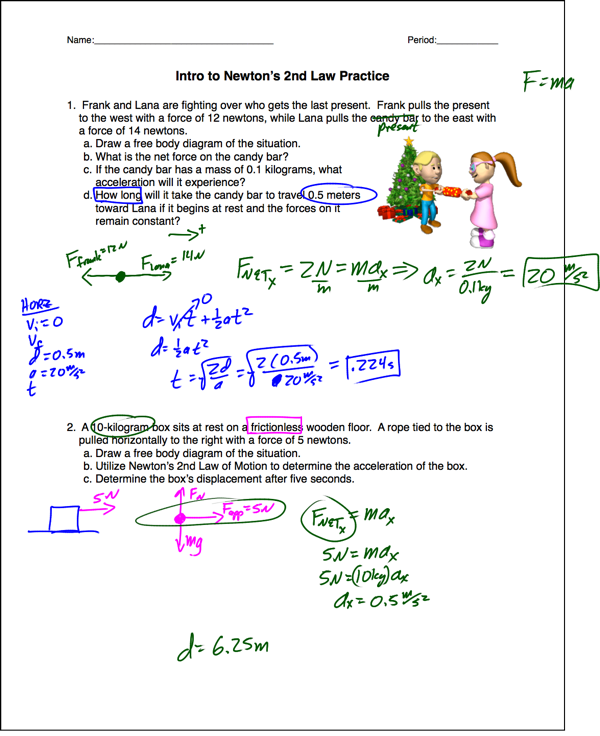
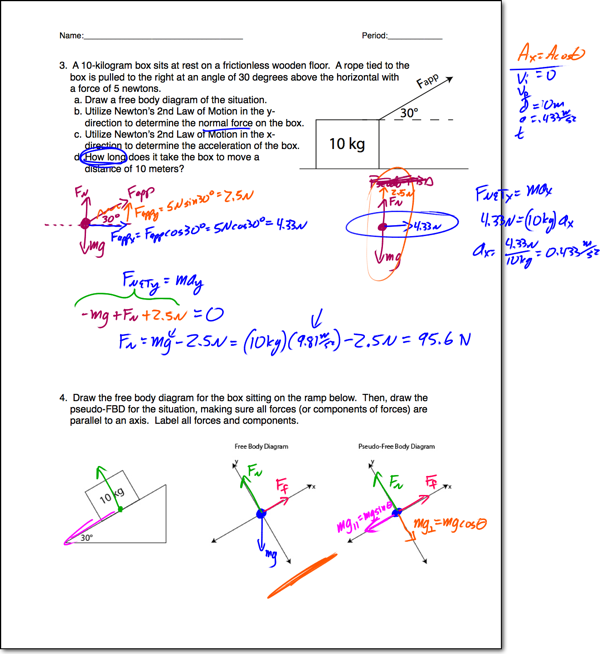




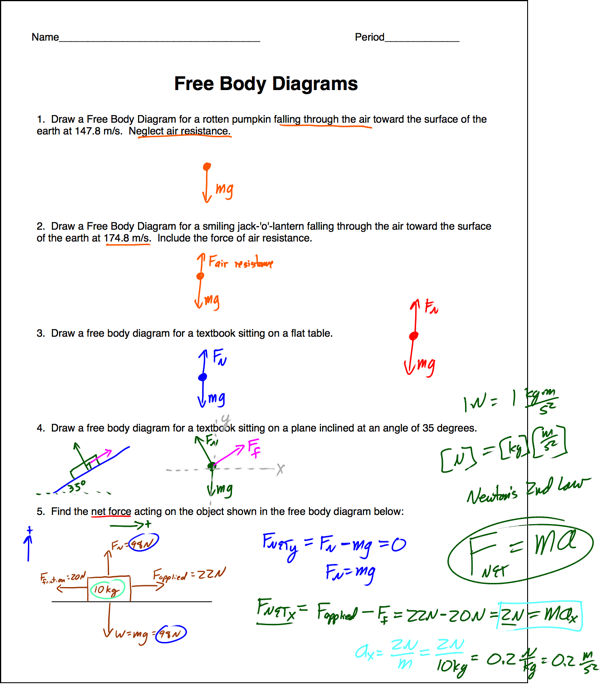
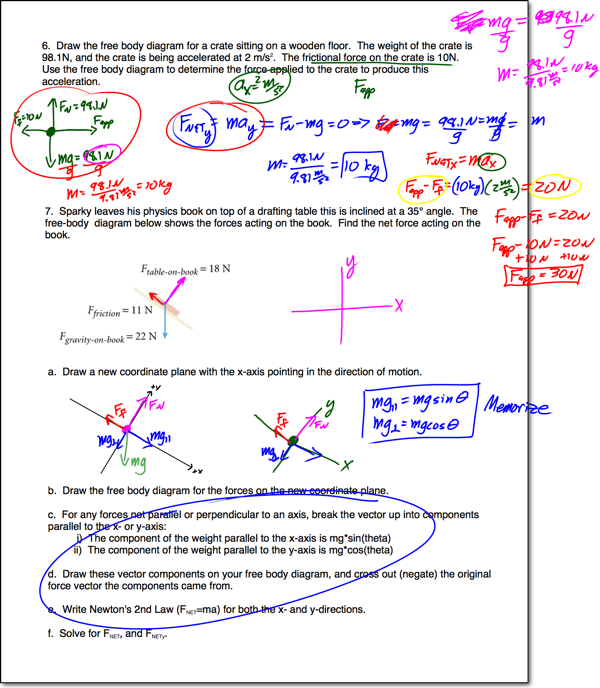

Newton’s 1st Law of Motion, also known as the law of inertia, can be summarized as follows:
“An object at rest will remain at rest, and an object in motion will remain in motion, at constant velocity and in a straight line, unless acted upon by a net force.”
This means that unless there is a net (unbalanced) force on an object, an object will continue in its current state of motion with a constant velocity. If this velocity is zero (the object is at rest), the object will continue to remain at rest. If this velocity is not zero, the object will continue to move in a straight line at the same speed. However, if a net (unbalanced) force does act on an object, that object’s velocity will be changed (it will accelerate).

This sounds like a simple concept, but it can be quite confusing because it is difficult to observe this in everyday life. We’re usually fine with understanding the first part of the law: “an object at rest will remain at rest unless acted upon by a net force.” This is easily observable. The donut sitting on your breakfast table this morning didn’t spontaneously accelerate up into the sky. Nor did the family cat, Whiskers, lounging sleepily on the couch cushion the previous evening, all of a sudden accelerate sideways off the couch for no apparent reason.
The second part of the law contributes a considerably bigger challenge to our conceptual understandings. Realizing that “an object in motion will continue in its current state of motion with constant velocity unless acted upon by a net force” isn’t easy to observe here on Earth, making this law rather tricky. Almost all objects we observe in our everyday lives that are in motion are being acted upon by a net force – friction. Try this example: take your physics book and give it a good push along the floor. As expected, the book moves for some distance, but rather rapidly slides to a halt. An outside force, friction, has acted upon it. Therefore, from our typical observations, it would be easy to think that an object must have a force continually applied upon it to remain in motion. However, this isn’t so. If we took the same book out into the far reaches of space, away from any gravitational or frictional forces, and pushed it away from us, it would continue moving in a straight line at a constant velocity forever and ever, as there are no external forces to change its motion. When the net force on an object is 0, we say the object is in “static equilibrium.” We’ll revisit static equilibrium when we talk about Newton’s 2nd Law.

The tendency of an object to resist a change in velocity is known as the object’s inertia. For example, a train has significantly more inertia than a skateboard. It is much harder to change the train’s velocity than it is the skateboard’s. The measure of an object’s inertia is its mass. For the purposes of this course, inertia and mass mean the same thing – they are synonymous.
And if you recall from the kinematics unit, a change in velocity is known as an acceleration. Therefore, the second part of this law could be re-written to state that an object acted upon by a net force will be accelerated. A more detailed description of this acceleration is given by Newton’s 2nd Law.

But, what exactly is a force? A force is a vector quantity describing the push or a pull on an object. Forces are measured in Newtons (N), named after Sir Isaac Newton, of course. A Newton is not a base unit, but is instead a derived unit, equivalent to 1 kg×m/s2. Interestingly, the gravitational force on a medium-sized apple is approximately 1 Newton.

We can break forces down into two basic types: contact forces and field forces. Contact forces occur when objects touch each other. Examples of contact forces include pushing a crate (applied force), pulling a wagon with a rope (tension force), a frictional force slowing down your sled, or even the force of air accelerating a spitwad through a straw. Field forces, also known as non-contact forces, occur at a distance. Examples of field forces include the gravitational force, the magnetic force, and the electrical force between two charged objects.

So, what then is a net force? A net force is just the vector sum of all the forces acting on an object. Imagine you and your sister are fighting over the last piece of licorice. You are pulling one end of the licorice toward you with a force of 5N. Your sister is pulling the other end toward her (in the opposite direction) with a force of 5N. The net force on the licorice, then, would be 0N, therefore there would be no net force. As it turns out, though, you have a passion for licorice, and now increase your pulling force to 6N. The net force on the licorice now is 1N in your direction, therefore the licorice would begin to accelerate toward you (yippee!) If it’s starting to sound complicated, it can be difficult to keep track of all the forces acting on an object just by writing those forces in words.
Fortunately, we have a terrific tool for helping us to analyze the forces acting upon objects. This tool is known as a free body diagram. Quite simply, a free body diagram is just a representation of a single object, or system, with vector arrows showing all the external forces acting on the object. These diagrams make it very easy to identify exactly what the net force is on an object, and they’re also quite simple to create:

As an example, let’s picture the example of an ice cream sundae, with whipped cream and chocolate sprinkles, sitting on the dining room table. We can represent our object (the ice cream sundae) in the diagram as a single dot. Then, we represent each of the vector forces acting on the sundae by drawing arrows and labeling them. In this case, we can start by recognizing the force of gravity on the sundae, known as the sundae’s weight. Although we could label this force as Fgrav, or W, we’ll get in the habit right now of writing the force of gravity on an object as mg. We can do this because the force of gravity on an object is equal to the object’s mass times the acceleration due to gravity, g.

Of course, since the sundae isn’t accelerating, there must be another force acting on the sundae to balance out the weight. This force, the force of the table pushing up on the sundae, is known as the Normal Force (FN). In physics, the normal force refers to a force perpendicular to a surface (normal in this case meaning perpendicular). The force of gravity on the sundae must exactly match the normal force on the sundae, although they are in opposite directions, therefore there is no net force on the sundae. The free body diagram for this situation would look like this:
As we close in on the end of our year in high school physics, I thought it’d be helpful to myself (and perhaps to others) to put together a compendium of some of the best Regents/Honors Physics resources to assist students in preparing for their final exams. Without further ado, and in no particular order:

APlusPhysics: Dan Fullerton’s (my) site to assist students and educators specifically around the NY Regents Physics curriculum, which has been expanding and generalizing to curricula outside the state as well. The Regents Physics section of the site, however, is by far the strongest and most complete. This site includes online tutorials covering the entire Regents Physics course, interactive quizzes pulling from a database of hundreds of old Regents Physics Exam questions, video tutorials of every major topic covered by the exam, and is also tied in quite closely with the Regents Physics Essentials review book. In addition, every Regents Physics questions from the past 16 exams has been pulled into worksheets by topic to allow for highly directed practice.
ScienceWithMrNoon: Brendan Noon‘s physics site has a wide variety of great content, including topic-based interactive quizzes and tons of great physics videos. His course calendar, as well, is loaded with tons of great resources by topic!
St. Mary’s Physics: Tony Mangiacapre‘s site, full of great lessons and interactive simulations across the entire Regents Physics curriculum. I’m especially fond of the Photoelectric Effect simulation — makes for a great computer-based lab activity! This site is also closely linked with Tony’s 123physics.com, featuring more than 1300 Regents Physics Exam questions broken down by topic for students to practice, as well as more great videos.
RegentsPrep.org: The Oswego City School District (with Dr. Tom Altman) has pulled together a strong collection of resources broken into Explanations, Demos, Labs, and Quizzes to assist students and educators in preparing for the Regents Physics exam.
Altman Science: The charismatic Dr. Tom Altman provides real-life demonstrations and explanations of physics concepts in action as part of the High School Physics Project. Further, he’s broken down a number of old Regents Exams and walked through solutions to each and every question in video format, page by page. In addition, his laser videos are “wicked cool” as well!
Past Regents Exams: The name says it all — an amazing archive of old Regents Physics exams!
Regents Physics Essentials: I’d feel negligent if I didn’t point out the Regents Physics Essentials review book I put together at student urging a few years back. There are a number of great review books to help students get ready for the exam, but this book takes a slightly different twist by providing students a straightforward, clear explanation of the fundamental concepts and more than 500 sample questions with fully-worked out solutions directly integrated in the text. As stated by my physics teaching cohort in crime at our high school, “the best review book is the one students will actually use,” and this was written to be friendly, fun, and concise. Plus, if students/teachers want extra problems without solutions given, the worksheets are available free online! You can check out the book’s free preview on APlusPhysics or use Amazon’s “Look Inside” feature!
Ref: APlusPhysics: RPE Ch. 7
Agenda:
Intro to Hooke’s Law
Hooke’s Law Lab
HW: Video and Questions, APlusPhysics: Springs, due 1/6 at 3 p.m.
Work and Power WS, due Friday at 3 p.m.
An interesting application of work combined with the Force and Displacement graph is examining the force applied by a spring. The more you stretch a spring, the greater the force of the spring… similarly, the more you compress a spring, the greater the force. This can be modeled as a linear relationship, where the force applied by the spring is equal to some constant time the displacement of the spring. Written mathematically:
![]()
F is the force of the spring in newtons, x is the displacement of the spring from its equilibrium (or rest) position, in meters, and k is the spring constant which tells you how stiff or powerful a spring is, in Newtons per meter. The larger the spring constant, k, the more force the spring applies per amount of displacement.
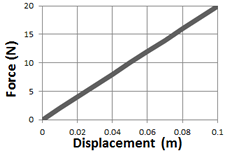
You can determine the spring constant of a spring by making a graph of the force from a spring on the y-axis, and placing the displacement of the spring from its equilibrium, or rest position, on the x-axis. The slope of the graph will give you the spring constant. For the case of the spring depicted in the graph at right, we can find the spring constant as follows:
![]()
You must have done work to compress or stretch the spring, since you applied a force and caused a displacement. How can you find the work done in stretching or compressing the spring? By taking the area under the graph. For the spring shown, to displace the spring 0.1m, we can find the work done as shown:
![]()
See if you can use Hooke’s Law to determine the spring constant in the problem below:
Homework: Watch Centripetal Acceleration Video and answer questions
The motion of an object in a circular path at constant speed is known as uniform circular motion (UCM). An object in UCM is constantly changing direction, and since velocity is a vector and has direction, you could say that an object undergoing UCM has a constantly changing velocity, even if
its speed remains constant. And if the velocity of an object is changing, it must be accelerating. Therefore, an object undergoing UCM is constantly accelerating. This type of acceleration is known as centripetal acceleration, and centripetal acceleration always points toward the center of the circle.
Circular Speed
So how do you find the speed of an object as it travels in a circular path?
The formula for speed that we learned in kinematics still applies.
v=d/t
We have to be careful in using this equation, however, to understand that an object traveling in a circular path is traveling along the circumference of a circle. Therefore, if an object were to make one complete revolution around the circle, the distance it travels is equal to the circle’s circumference.
C=2*Pi*r